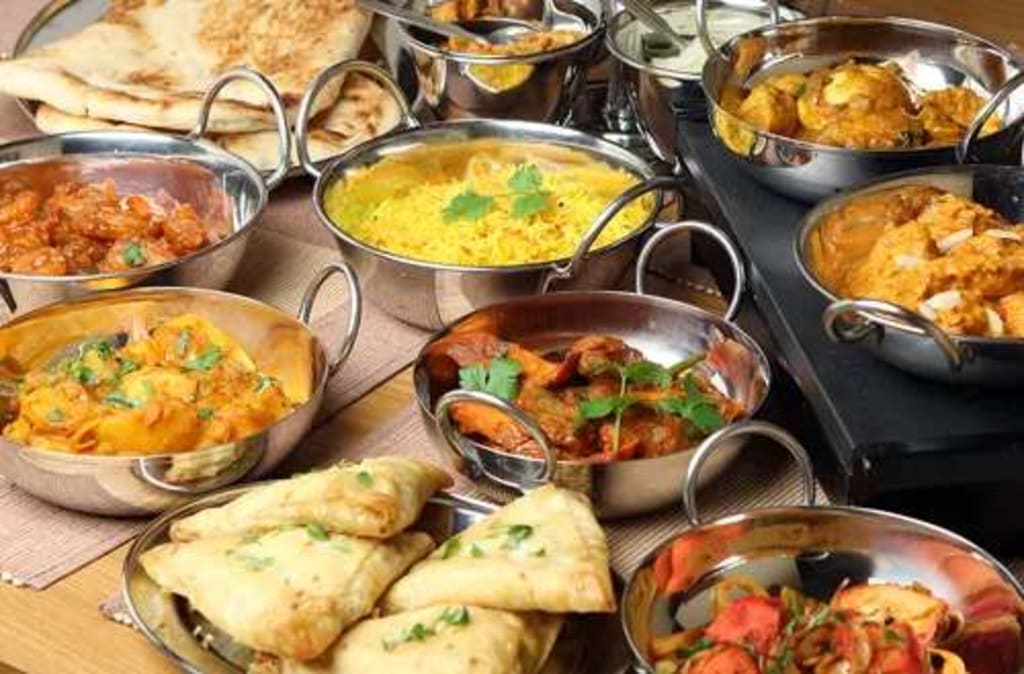Culinary Tapestry of Pakistan:
A Journey Through Its Popular Foods

Pakistan, a place where there is different scenes and societies, flaunts a rich culinary legacy that mirrors its perplexing history and multicultural society. From the clamoring roads of Karachi to the uneven locales of Gilgit-Baltistan, Pakistani food is an energetic mosaic of flavors, fixings, and methods. This article investigates probably the most famous food varieties in Pakistan, digging into their starting points, arrangement strategies, and social importance.
1. Biryani:The Crown Gem of Pakistani Cooking.
Biryani is apparently the most dearest dish in Pakistan, celebrated in each side of the country. This fragrant rice dish, layered with marinated meat (typically chicken, sheep, or hamburger), flavors, and some of the time vegetables, follows its beginnings to the Mughal period. The intricate transaction of flavors like saffron, cardamom, and cloves, joined with the extravagance of ghee, makes an orchestra of flavors that charms the faculties. There are provincial varieties of biryani in Pakistan, each with its special contort. Sindhi Biryani, known for its hot kick and tart notes, integrates yogurt, tomatoes, and potatoes. Interestingly, Karachi Biryani frequently incorporates bubbled eggs and seared onions, adding additional layers of surface and flavor.
2. Nihari: The Good Breakfast Staple.
Nihari, a sluggish cooked stew of hamburger or leg of lamb, is a quintessential breakfast dish in Pakistan. Starting from the Mughal kitchens of Old Delhi, this dish advanced toward Pakistan after the segment and immediately turned into a number one. The name "Nihari" comes from the Arabic word "Nahar," signifying "morning," mirroring its conventional utilization as a morning dinner. The readiness of Nihari includes stewing meat in a mix of flavors, including fennel, cumin, and garam masala, for a few hours until it becomes delicate and tasty. Frequently embellished with new coriander, ginger, and a press of lime, Nihari is best delighted in with naan or paratha.
3. Haleem: An Image of Solidarity and Custom.
Haleem is a rich, nutritious dish produced using a combination of wheat, grain, lentils, and meat, regularly sluggish cooked flawlessly. It holds critical social and strict significance, particularly during the Islamic month of Muharram and the blessed month of Ramadan, when it is normally served at collective get-togethers. The creation of Haleem is a work concentrated process that can require as long as twelve hours. The sluggish cooking permits the flavors to merge together, making a rich consistency. Flavors like dark pepper, cinnamon, and cloves inject the dish with warmth and profundity. Haleem is frequently finished off with broiled onions, new coriander, and lemon wedges, adding an explosion of newness to its generous base.
4. Chapli Kebab: The Pride of Peshawar.
Chapli Kebab, a specialty from the Khyber Pakhtunkhwa territory, is a hot, delicious meat patty produced using minced hamburger or sheep. The name "Chapli" is gotten from the Pashto word "Chapdikh," signifying "level," alluding to its shape. These kebabs are ordinarily implanted with a blend of pomegranate seeds, coriander, and chilies, which gives them their particular flavor. Generally cooked on a huge, level frying pan, Chapli Kebabs are fresh outwardly and succulent within. They are frequently presented with naan, yogurt sauce, and new plate of mixed greens, making for a delightful and fulfilling dinner.
5. Karahi: An Observed Culinary Encounter.
Karahi, named after the wok-like cooking vessel in which it is ready, is a cherished dish all through Pakistan. This dish is normally made with chicken or lamb, cooked with tomatoes, green chilies, ginger, garlic, and a mix of flavors. The way in to a decent Karahi lies in its straightforwardness and the newness of its fixings. There are two famous renditions of Karahi: the Lahori Karahi, which is marginally tart because of the utilization of tomatoes and yogurt, and the Peshawari Karahi, which is more clear, zeroing in on the unadulterated kinds of meat and green chilies. The two renditions are delighted in with naan or roti, making for a shared eating experience.
6.Saag : The Flavor of Punjab.
Saag, a term utilized for verdant green vegetable dishes, is a staple in Punjabi cooking. The most famous adaptation is Sarson ka Saag, produced using mustard greens and frequently presented with Makki di Roti (cornbread). This dish is especially delighted in throughout the cold weather months and is an image of country Punjabi culture. Readiness of Saag includes slow-cooking the greens until they are delicate and afterward squashing them into a coarse glue. The dish is enhanced with garlic, ginger, and green chilies, and is frequently wrapped up with a dab of custom made margarine or ghee. The natural, gritty kinds of Saag are an ideal counterpart for the generous cornmeal roti.
7. Samosa: The Pervasive Tidbit.
Samosas are universal in Pakistan, delighted in as a bite or canapé. These broiled cakes are commonly loaded up with flavored potatoes, peas, and here and there minced meat. Their fresh, brilliant outside and exquisite filling make them a #1 at break times and merry events. Samosas are accepted to have begun in Focal Asia and advanced toward the Indian subcontinent through shipping lanes. In Pakistan, they are frequently presented with chutneys, for example, tamarind or mint, which supplement the rich kinds of the filling.
8. Paya: The Spirit Warming Delicacy.
Paya, signifying "trotters" in Urdu, is a conventional dish produced using the feet of goats, sheep, or dairy cattle. This coagulated stew is gradually cooked with a mix of flavors, onions, and garlic, bringing about a thick, tasty stock. Paya is especially well known in the Punjab and Sindh districts, frequently delighted in as a morning meal dish with naan or roti. The arrangement of Paya requires persistence, as the need might arise to be cooked for a few hours to accomplish the ideal delicacy and to remove the collagen that gives the stock its remarkable surface. The dish is frequently embellished with new coriander and ginger, adding an eruption of newness to the rich, good stew.
9. Gol Gappa: The Road Food Sensation.
Gol Gappa, otherwise called Pani Puri or Phuchka in different pieces of South Asia, is a cherished road food in Pakistan. These scaled down, empty puris are loaded up with a hot, tart combination of tamarind water, chickpeas, and potatoes. The eruption of flavors and surfaces with each nibble makes Gol Gappa an overwhelming treat. Merchants selling Gol Gappa can be tracked down on city intersections and in clamoring markets, serving them new to excited clients. The experience of eating Gol Gappa is as much about the public delight and exuberant air for all intents and purposes about the flavors.
10. Chana Chaat: The Energetic Plate of mixed greens.
Chana Chaat is a lively and reviving serving of mixed greens produced using chickpeas, tomatoes, onions, and different flavors and chutneys. This dish is a famous tidbit and road food, especially during the sweltering mid year months. The mix of tart, fiery, and sweet flavors, alongside the crunchy surfaces, makes Chana Chaat a magnificent treat. Frequently embellished with new coriander, green chilies, and lemon juice, Chana Chaat isn't just heavenly yet additionally nutritious, offering a sound option in contrast to heavier bites.
11. Zarda: The Sweet Closure.
Zarda is a conventional sweet dish produced using rice, seasoned with saffron, cardamom, and sugar, and frequently embellished with nuts and dried natural products. This energetic yellow pastry is commonly served at weddings, celebrations, and other celebratory events. The name "Zarda" comes from the Persian word "Zard," signifying "yellow," mirroring the dish's unmistakable variety. The utilization of saffron and cardamom gives Zarda its sweet-smelling and lavish person, making it a fitting finish to a luxurious Pakistani feast.
Conclusion
The culinary scene of Pakistan is pretty much as different and energetic as its kin. Each dish recounts to a story, mirroring the country's rich history, social legacy, and the glow of its neighborliness. From the zesty charm of Biryani to the consoling hug of Haleem, Pakistani cooking offers a tangible excursion that is both fulfilling and remarkable. Whether delighted in a side of the road diner or a family kitchen, these well known food varieties typify the essence of Pakistan, offering a sample of its rich and changed culinary practices.
About the Creator
Ovijit paul
I am a food blogger and I blog about popular foods from different countries. Hope you like my writings.






Comments
There are no comments for this story
Be the first to respond and start the conversation.